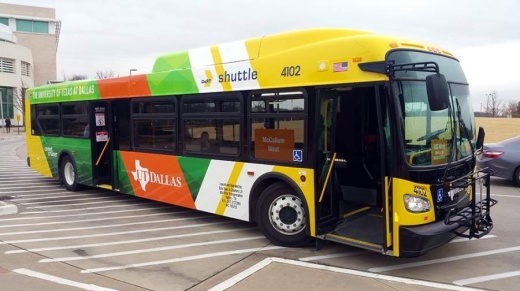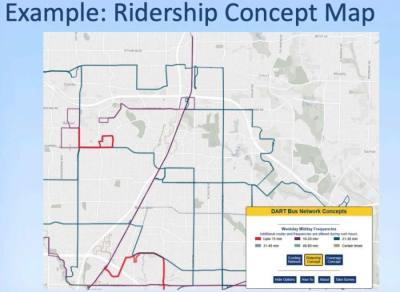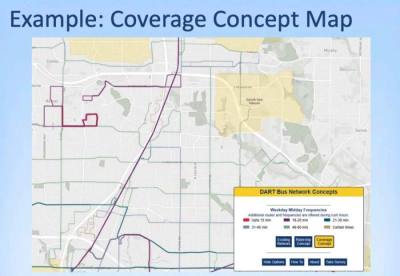The next phase of the DARTzoom seeks to redo Dallas Area Rapid Transit’s entire 13-city bus network, Mark Nelson, director of transportation for the city of Richardson, told the council May 4.
To oversee the project, DART hired public transit consulting firm Jarrett Walker + Associates, which recently headed up Houston’s bus network redesign. DART’s plan would be budget neutral because it does not include any service additions, Nelson said.
The transit agency is currently weighing two approaches for the redesign. The first would augment the system based on ridership. The second would focus on increasing coverage.
About 55% of DART’s bus service currently focuses on high ridership routes, while the rest is used to provide coverage, Nelson said. If the transit agency focused its redesign around ridership, that share would shift to 85% ridership, 15% coverage.
The ridership approach would direct a majority of resources toward high-density corridors, Nelson said. In Richardson, those may include Coit Road, routes that service The University of Texas at Dallas, Plano Road, Jupiter Road and East Arapaho Road. Areas that could see a decrease or loss of service include West Arapaho Road and West Belt Line Road.
The alternative, which prioritizes coverage over ridership, would provide less frequent bus service to a larger geographic area, Nelson said. Under that plan, 60% of resources would be directed toward coverage, while the remainder would be used for ridership.
In the coverage concept prototype presented to council, service on parts of Coit, Jupiter and Plano roads would decrease in frequency. However, unlike the ridership prototype, buses would continue to run on West Arapaho and West Belt Line. Service on West Spring Valley Road would increase in frequency, Nelson explained.
The coverage concept map also includes a GoLink service area in the northeast part of the city. This would provide an on-demand, Uber-like service to riders in that area. The taxis would be handicap accessible, which is something not currently offered in most rideshare vehicles, Nelson said.
“GoLink has been well received in the areas where it is offered,” he said.
Council member Ken Hutchenrider said he was concerned by the loss of service presented in the coverage map example. Member cities in DART’s network contribute 1% of sales tax to fund the agency’s operations. Hutchenrider said he wondered whether residents would still get their money’s worth with fewer routes.
“If we do have less coverage at the end of this, and we are still being charged the full penny, how is that win for our community and for our citizens?” he asked.
Richardson’s investment in its Innovation Quarter is based around multimodal transit offerings, including bus service provided by DART. Reduction of service could deter new businesses from joining the area, Council Member Bob Dubey said.
“We’ve committed to one thing, and we weren’t looking at reduced transportation times,” he said.
Steve Mitchell, council’s most tenured member, said the city should be forward-thinking when making these decisions.
“We always want to be diligent not of where we are today but where we think we are going to go,” he said.
Map examples presented May 4 show the extreme of both concepts, Nelson said. The transit agency expects the final result to be a compromise between ridership and coverage.
“They are trying to figure out how to make it fair and equitable,” he said.
Much of the original timeframe for planning and implementation of the project has been delayed due to COVID-19, Nelson said. A final draft of the plan is expected to be approved in fall 2020 or in the early months of next year. Public meetings would follow in spring 2021. Final approval of the plan is scheduled for summer 2021. Service changes are expected to roll out in May 2022.
For more information on DARTzoom, visit this link.








